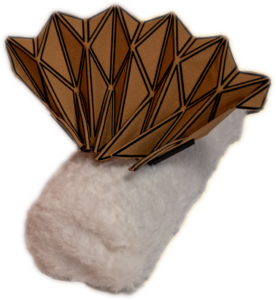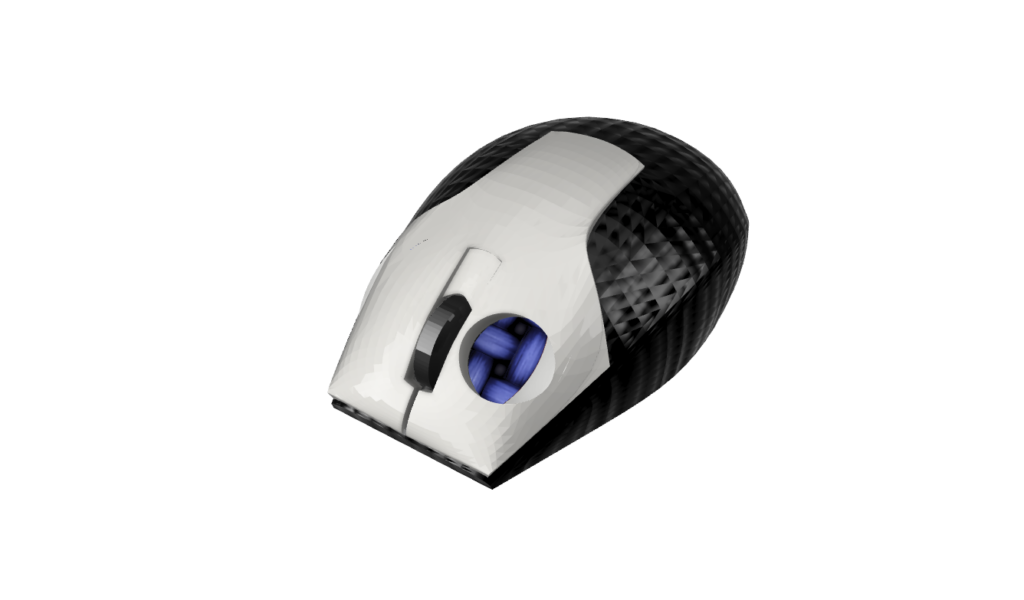



This work explores making intelligent agents tangible through shape-change within the context of shopping clothes online. The tangible prototypes created from the co-design sessions can be taken along as inspiration for future concepts in the field of intelligent agents and shape-changing interfaces. Furthermore, the results of this also clarify the usefulness of shape-change in the context of shopping clothes online. Ultimately, the four important themes, namely: (1) Function, (2) Type of Shape-change, (3) Physical Appearance, (4) Interaction, are linked to each other within this research, resulting in three concepts. The future scenarios with elaboration on the field of Artificial Intelligence and Shape-change are inspiration and examples of how shape-change can be combined with AI to create a tangible interaction loop to make AI transparent and understandable. The three artifacts made from these concepts, which were eventually tested in a preliminary study during an exhibition, demonstrating what the experience can be like with the different types of shape-change within a context. The combination of different types of shape-change with making intelligent agents tangible provides enough possibilities for the future to eventually be able to live in a world with shape-changing interfaces and tangible, understandable and transparent intelligent agents.

Below are the reflections on my FMP within the different areas of expertise.
For the first time, I designed and executed a co-design session during this project. This was one of the goals I set for my Final Master’s Project as I wanted to gain more experience in various user methods so that I could have a variety of skills and expertise within these methods and know when to use which method. I found out that I get energy from creating and conducting co-design sessions. The well prepared materials made me feel at ease during the sessions as I knew what my plan was and how we were going to perform the different steps. The booklet, which the participants had to fill in prior to the co-design session, helped introduce them to the subject and thus, they arrived at the session prepared. In addition, the customer journey map was a good tool to stimulate discussions between the duos. In addition, the scenario cards and interaction cards also helped as a tool for an additional iteration for the prototypes. Furthermore, the shape-changing demos were valuable tools to experience the different shape-change types to initiate the through process of the participants. Eventually, these sessions have led to a lot of data in the field of online shopping for clothing, as well as in the field of shape change.
As a result, I have clearly seen the value of these sessions, and in the future, I would like to create and conduct more of these sessions or workshops as I really enjoy doing it. By means of the co-design session, concepts and prototypes could be quickly generated and researched. The combination of being a user and experts of the designers as participants made it possible to search for the needs of the users and also to create many creative prototypes with shape-change and be able to compare them.






During this project, I tried to find an interesting play between different textures to elicit different emotions and interactions. For example, “The Peacock”, where the cylinder is made of fluffy soft fabric, and there were visitors who mistook it for an animal or wanted to pet it. This has taught me to keep looking further and further into materials, and I would like to do even more research in the future on how materials can influence designs and prototypes.
Furthermore, my previous designs during my master’s were often bold and remarkably colorful. I wanted to play with bold colors to make my designs stand out. However, during my graduation project, I learned that simple colors and keeping them elegant and understated can also be enough for a striking design, as long as it is well designed and is a whole. Furthermore, I learned that a “form family” is essential, especially if you make multiple artifacts. I found it fun and interesting to play with this and learned that color could influence how a design is received. In the future, I will continue to pay attention to color use and material choices to create the right designs for the right research context.
For this project, I explored in different ways, namely digitally and physically. I have learned that I like the combination of the two exploration techniques. With digital exploration, I can clearly visualize my concepts and explore with the use of color. This way I can translate my ideas digitally, after which the first drafts are made into physical prototypes, something I often do using Fusion360 and 3D printing. On the other hand, with physical exploration, I can explore materials and gain knowledge of how the material moves or reacts, and easily make material combinations. In addition, I can explore with different techniques how the materials can best be explored and processed to achieve the correct and most beautiful result. I will continue to alternate between these two exploration methods for future projects to explore different designs and prototypes.
A big learning point for me during this project is “Less is More”, as I am often very ambitious and want too much. When realizing the artifacts, I went back to the basics and looked at what was essential to achieve the prototype’s goal: making the shape-change types experienceable. This helped me to build the three artifacts step by step and not get distracted. In addition, it emerged that prototyping was easier for me because of the previous experience of other projects and courses, but also by being able to focus. I went to work step by step, such as with “The Peacock” where I first explored the 3Dprinted origami structures on fabric in order to get to know the material. The same applies to programming, where it is essential to look at the different components and check everything step by step to see if it works. I have made significant steps in this and will continue to work in this focused way in future projects to create the desired prototype for the specific studies.
The most exciting but also what I wanted to learn the most was how to get the inflatable system working. Where I normally use servos for shape-change, I wanted to expand my expertise and gain more experience within and with a different method of making shape-change experienceable. This meant that I started working with inflatables, which was entirely new for me. The part where I was most afraid was working with and regulating the current and different voltages. However, by having done this, I can tackle controlling the current and voltage within a circuit with components that require different voltages more confidently in future projects. In addition, this realization of the inflatable was also the most challenging part, where everything had to be airtight, the voltage had to be regulated within the circuit, and the pressure in the inflatable had to be well controlled. However, I have now gained expertise in how I could work and prototype in the field of inflatables in future projects.




An important goal of mine during this project was to learn about Artificial Intelligence (AI) to expand my knowledge to research and design for it. To do so, I attended several lectures and workshops and read a book about AI. This helped me gain different insights about AI, from the philosophy to the technical aspects. The knowledge gained during these activities differed form the theoretical papers that I have previously read on the subject as it allowed me to hear individual opinions and talk about it with other people. Despite the described activities, my knowledge on AI is not yet where I want it to be, and sometimes the black box closes for me again. At the end of my project, I needed an expert to talk about the AI part of my project. I learned from this that discussing and consulting about AI helps a lot in understanding and thinking about it, especially in a particular context. In the future, I hope to be able to design an understandable intelligent system and use it to conduct user studies.
Furthermore, my skills in using the Fusion360 program have improved considerably during this project. While at the start of my master I still found it challenging to think about giving the electronics a place in the prototype, I was now doing calculations to get the electronics neatly fitted in my 3D design. As a result, I could iterate faster, and with the correct measures, there were fewer 3d printed iterations that needed to be thrown away due to incorrect measurements or assumptions. Could go in the trash. The most important lesson here is “Meten is weten”, to ensure well-built prototypes.
For the analysis of the prototypes of the co-design sessions, I made a table to be able to make links between different aspects. This is a self-formed analysis and framework to create insights from the data received. I find this very difficult as I feel that this has not been validated by other people. However, I know that I need to assume that I have now saturated enough knowledge within my master to be able to do my own analyses. In addition, I had to distinguish myself from useful information retrieved from the co-design sessions of the project and additional insights as I am often curious about all kinds of data and what it could possibly tell. It helped to keep reflecting on the research questions and to keep addressing them. My goal in the future is to be more confident in my own analyzes and possibly even develop my own methods.
In the field of Business & Entrepreneurship, I learned a lot during my graduation project. At the beginning of this project, I was still hopelessly looking for a client for my project, I discovered how commercial companies are set up. I was shocked by the lack of involvement of users during processes and the non-ethical approach to different concepts. Of course, this is different for every company, but it did open my eyes. Because of this, I moved more towards the research side, and by presenting different works at different conferences, I saw how fascinating the research world could be. In addition, I learned how to present your work professionally during multiple conferences. During the search for a client, I improved my networking skills as well. I implemented these skills during one of the conferences that I attended to seek for interesting collaborations or potential PhD positions.

This project is in line with my vision that shape-changing interfaces can contribute to making AI understandable, transparent, and reliable. Furthermore, it has given me insights that exploring different materials and shape-change types can contribute to dealing with shape-changing interfaces and have gone a step further in introducing shape-change into society. In addition, my skills in making prototypes in an aesthetic way and in an experienceable way in the field of shape-change have improved and can help me realize concepts in future projects. In addition, I learned to set up and professionally conduct a co-design session and establish good connections and conversations with users, experts, and companies. Furthermore, it has contributed to the experience of placing my research in existing research and conducting research through design. Experiences primarily guide the process, and the results of the studies and the critical values have been established. In the future, this can help me conduct research, create user studies and prototype to make the transition of emerging technologies easier in society.
